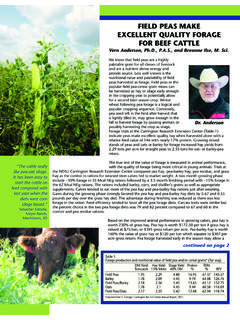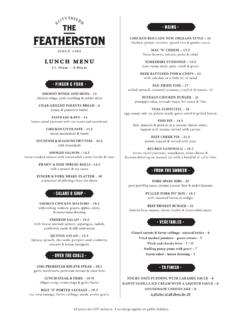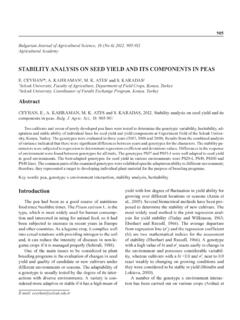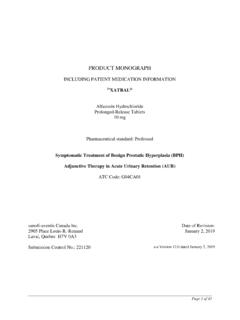Transcription of FIELD PEAS AS FEED FOR LIVESTOCK - northernpulse.com
1 FIELD PEAS AS FEED FOR LIVESTOCK An incredible new feed grain has recently been recognized for it s potential contribution to the LIVESTOCK industry. FIELD pea (Pisum sativum) is an annual cool-season grain legume grown predominantly in the Northern Plains with significant potential as a feed for LIVESTOCK . North Dakot a and Montana lead the nation in FIELD pea production. FIELD peas that do not make the quality specifications for human food have significant market potential as a LIVESTOCK feed. FIELD peas and pea- cereal grain mixtures can be grown for forage (hay or silage) and pea residue after grain harvest ca n be fed to ruminant animals. Regional interest in peas as feed Several research trials have been conducted to investigate FIELD peas in LIVESTOCK diets at North Da kota State University and at other regional universities. Peas can be used effectively and efficiently in several different types of LIVESTOCK diets including beef and dairy cattle, sheep, bison, swine, and poultry.
2 The unique and thorough digestion parameters of peas make it a safe and nutritious feed grain for all species. Nutritional value of FIELD peas The FIELD pea is a nutrient dense grain (60 lb/ bushel) with energy equal to corn on a weight basis and nearly three times the crude protein. Both starch and fiber components are energy sources. Palatability and digestibility of FIELD peas are positive attributes of this grain legume. Since fie ld peas ferment slower and more thoroughly than some other feed grains, stable and efficient rumen function is maintained. These traits may serve to keep animals on feed during stress periods and improve growth rate and feed efficiency over other ration ingredients. FIELD peas have excellent binding characteristics in the manufacture of pellets or range cow cakes. Peas increase the durability and reduce the fines when used in formulations at 10%-40% of the feed product.
3 In addition, peas add critically important rumen degradable protein to cake for wintering cows that are consuming low quality forage. Peas are also an excellent ingredient in creep feeds. Co w-calf producers are asking for peas in their creep feed and in their range cake because they see value in the palatability and animal performance. FIELD pea research Including FIELD peas in beef cattle rations has supported equal weight gain with improved feed effic iency in some cases or improved intake and weight gain compared to traditional feeds. Peas are best used in diets where pal atability and nutrient density are critically important, such as creep feeds or weaned calf rations. We observed similar an d positive results for feeding feed grade FIELD peas, chick peas or lentils to newly weaned calves. Cattle made the best use of rol led peas vs. whole or finely ground grain. Feeding peas is highly recommended in weaning and growing rations with 20%-30% peas in the diet.
4 Fin ishing feedlot cattle can benefit from peas as a protein source, especially in corn based diets. Peas fed at 15% of a well formulated diet generally provide enough protein to realize the genetic potential of our modern feeder cattle. A highly intere sting response has been observed when peas are fed to finishing steers. Carlin et al. (2006) reported that inclusion of 10% or more FIELD peas in the ration for 75 days increased the tenderness and juiciness of ribeye steaks. More details on this highly positive and the very unique effect of FIELD peas in beef cattle diets will be provided in future articles. FIELD peas can be used very successfully in rations for dairy cattle and sheep, replacing some of the concentrate while adding supplementary protein. Lactating dairy cattle require high levels of protein and unique contribution of both energy and protein from peas make it an ideal feed for milking cows.
5 In sheep finishing diets, FIELD peas included at up to 45% of the ration resulted in a highly acceptable replacement in corn based diets producing exceptional growth of lambs. In non- ruminants such as swine and poultry lower inclusion such as 10%-30% of diets may be used successfully depending on stage of production. Conclusion FIELD peas are a nutrient dense grain legume and an excellent feed for many different classes and production scenarios of LIVESTOCK . Used as a protein source or replacement concentrate grain, LIVESTOCK producers have an opportunity to utilize this unique and beneficial feed ingredient. Peas are an excellent source of natural protein. I use them in diets for developing purebred bulls and in creep feed for calves. Dewayne L. Siebrasse, President, Nutritional Consultant, CattleCents Consulting Inc., Aberdeen, SD. Table 2. FIELD pea grain, pea co-products and pea forage nutrient analysis.
6 Item Pea Pea Pea Pea Pea Pea Grain Hulls Screenings Hay Straw Silage Dry matter, % 88 92 90 88 89 35 % Dry Matter Crude protein, % Total digestible nutrients, % NEm, Mcal/lb NEg, Macl/lb Calcium, % Phosphorus, % Adapted from Lardy et al., 2009. Alternative Feeds for Ruminants. AS-1182 p. 21. Table 1. Comparison of nutrient value of LIVESTOCK feed grain with FIELD peas. Item FIELD peas Corn Barley Dry matter, % 89 88 88 % Dry Matter Crude protein, % Total digestible nutrients, % NEg, Mcal/lb Rumen undegradable protein, % Calcium, % Phosphorus, % Fat,% Adapted from Anderson et al., 2007. AS-1301 and NRC, 1996. USING FIELD PEAS IN BEEF COW/CALF OPERATIONS North Dakota and Montana have led the nation in FIELD pea production for the past several years. FIELD peas that do not make grade for the human food market can be marketed as excellent quality feed LIVESTOCK .
7 Beef cattle are the primary LIVESTOCK enterprise in the region and can utilize significant amounts of peas. There are several different production scenarios in the cow/calf enterprise where peas can be used to advantage. Peas make a palatable and highly digestible supplement for wintering beef cows on low quality forage. FIELD pea and cereal grain (forage barley or oats) grown together can be harvested as dry hay or ensiled to provide high quality forage. Pea residue is also useful to beef cows but the nutrient density is not as high as the pea hay or silage. After grain harvest, a second crop of peas may be possible for for age if light tillage follows the combine and moisture is available. This forage can be grazed, or possibly cut for hay or ploughed do wn as a green manure. FIELD peas in beef cow rations Peas provide a highly rumen degradable protein source required by beef cows.
8 The rumen degradable pr otein supports healthy microbial populations that can digest forage more thoroughly. Energy from starch and digestible fibe r further supports ruminal digestion. Use of home-grown peas for winter supplementation can reduce purchased feed inputs and tr ansportation costs and improve crop rotations. There was a tendency for improved beef cow performance with processed peas ( dry rolling) over whole peas when fed as a supplement to forage diets. The rate of passage in high forage diets reduce s time for digestion of whole peas. Mature beef cows chew their cud which may be thorough enough for nominal nutrient util ization. FIELD peas for developing bulls There is no formal research evaluating the use of FIELD peas for developing breeding bulls, however, experience from some exceptional seedstock producers indicates a strong preference for FIELD peas in growing bull rations.
9 Some seedstock operations include peas in their bull grower diets and like the positive effect on muscle development and feet and legs. The slow and thorough digestion of FIELD peas may contribute to this positive effect. In addition, bulls are said to be more satisfied. Some producers grow their own peas like Gelbvieh breeders, Louis and Rob Arnold from Esmond, ND. Others c ontract or purchase peas from area farmers. The long term use of peas by producers selling exceptional beef genetics is testament to the value of FIELD peas in this production scenario. Using peas to manufacture cake and pellets Peas are an excellent binder for the manufacturing of high quality pellets or for range cakes or c ubes, which are essentially a large diameter pellet. Cake products and pelleted feeds formulated with other co-products can use pe as to add hardness and durability. Some LIVESTOCK producers are asking their feed suppliers specifically for peas in their creep feed and/or cow cake as they recognize the palatability and excellent animal condition observed from feeding peas.
10 FIELD peas in creep feed The palatability, digestibility, and nutrient density of FIELD peas provide for a unique ingredient in creep feeds. Calves grew fastest with peas in the creep feed. Our current recommendation is to use 20%-40% FIELD peas in creep formulations. Peas should be processed by dry rolling in home formulated creep feeds. Concluding thoughts FIELD peas are an excellent feed for beef cows, calves, and bulls. Used as a protein source or energ y concentrate, regional producers have a very palatable and economical feed available to them. Creep feed and bull development rations can use peas as an ingredient in the formulation for excellent animal performance. I feed peas before weaning to cows and calves. I mix peas with chopped hay and silage so calves are used to feed at weaning. Then I use peas in the weaning ration and the calves continue to eat well.







